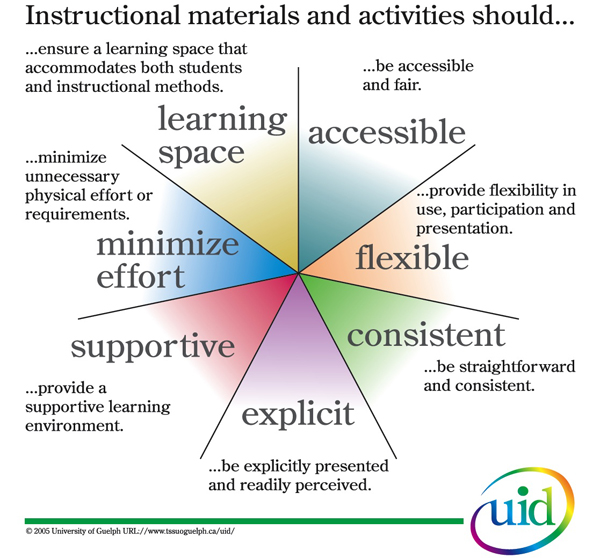- provide multiple means of representation to give learners various ways of acquiring information and knowledge
- provide multiple means of expressing their learning and what they know
- provide multiple means of engagement to tap into student interests and motivate them to be open to new learnings
Providing curriculum alternatives makes learning more accessible to all students, despite differences in backgrounds, learning styles, abilities, and disabilities. The key is not one optimum solution for all students, but rather differentiating to accommodate individual students needs. Educators can do this by making sure that instructional materials follow certain principles. The diagram below illustrates this type of learning environment.

Within my own teaching practices, I am always looking for ways to differentiate my learning tasks, and move towards a more universal design that would comprise my classroom community. I have many unique needs within my own classroom, and attempt to structure my teaching practices so they can address the different types of students and the ways they learn best.
To support reading, I provide students with the opportunity to not only read independently, but they also have opportunities to read with their peers, read with the teacher, or even read online, listening to audio books from multiple genres. I've found that by differentiating my reading practices within my language program, I can individualize student goals when reading, and better support their needs. Technology is a daily tool we use within my classroom, as students are always using laptops, Chromebooks, and personal devices to support research, work on writing, complete projects or presentations, and present their learning. This has assisted in increasing student participation, engagement, and motivation within my class.
Finally, I try to differentiate the ways I present new materials and key learnings within my teaching practices. When teaching about space and the planets, I've presented the material during class discussions of what the students already know of the planets, completing readings, looking at websites, and showing videos. These different forms of media help to address multiple learners, and the repetition assists in the embedding of key learnings during teaching moments. Each of these classroom practices demonstrates a functioning Universal Design model within the classroom. Multiple reading forms, use of technology, and multiple means of presenting learning address the three key areas of the Universal Design for the classroom, one that differentiates the means to engage, learn, and express learning.
No comments:
Post a Comment